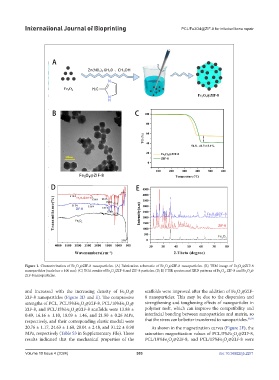Page 311 - IJB-10-4
P. 311
International Journal of Bioprinting PCL/Fe3O4@ZIF-8 for infected bone repair
Figure 1. Characterization of Fe O @ZIF-8 nanoparticles. (A) Fabrication schematic of Fe O @ZIF-8 nanoparticles. (B) TEM image of Fe O @ZIF-8
4
3
4
3
4
3
nanoparticles (scale bar = 100 nm). (C) TGA results of Fe O /ZIF-8 and ZIF-8 particles. (D, E) FTIR spectra and XRD patterns of Fe O , ZIF-8 and Fe O @
3
4
4
3
4
3
ZIF-8 nanoparticles.
and increased with the increasing density of Fe O @ scaffolds were improved after the addition of Fe O @ZIF-
4
3
3
4
ZIF-8 nanoparticles (Figure 2D and E). The compressive 8 nanoparticles. This may be due to the dispersion and
strengths of PCL, PCL/5%Fe O @ZIF-8, PCL/10%Fe O @ strengthening and toughening effects of nanoparticles in
4
3
4
3
ZIF-8, and PCL/15%Fe O @ZIF-8 scaffolds were 13.88 ± polymer melt, which can improve the compatibility and
3
4
0.49, 16.16 ± 1.10, 18.09 ± 1.46, and 21.50 ± 0.26 MPa, interfacial bonding between nanoparticles and matrix, so
respectively, and their corresponding elastic moduli were that the stress can be better transferred to nanoparticles. 38,39
20.76 ± 1.17, 24.63 ± 1.60, 28.04 ± 2.48, and 31.22 ± 0.98 As shown in the magnetization curves (Figure 2F), the
MPa, respectively (Table S3 in Supplementary File). These saturation magnetization values of PCL/5%Fe O @ZIF-8,
4
3
results indicated that the mechanical properties of the PCL/10%Fe O @ZIF-8, and PCL/15%Fe O @ZIF-8 were
3 4 3 4
Volume 10 Issue 4 (2024) 303 doi: 10.36922/ijb.2271

